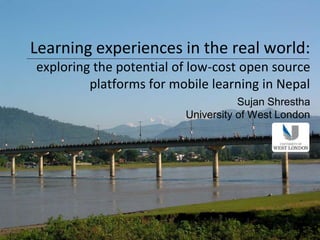Learning experiences in the real world: exploring the potential of low-cost open source platforms for mobile learning in Nepal
- 1. Learning experiences in the real world: exploring the potential of low-cost open source platforms for mobile learning in Nepal Sujan Shrestha University of West London
- 3. Nepal
- 4. Computers are the What we like best medium for learning and to believe? securing the future of children
- 5. • 86% - live in rural areas • 42% - below national poverty line • urban/rural differences in access to markets, services and information (Bennett, 2005) • 36 distinct ethnic, speak over 50 languages • diversity in tradition and their culture ICT 4 D: The road 2 development
- 8. Reality Check ekantipur.com
- 9. 90 Mobile Penetration Increasing? World = 78.58% 80 Yes Yes.. But... 70 60 50 40 Nepal = 30.69% 30 20 10 0 1960 1975 1987 2002 1963 1966 1969 1972 1978 1981 1984 1990 1993 1996 1999 2005 2008 2011
- 10. Internet Users (per 100 people) 35 30 25 World WLD Nepal NPL 20 15 10 World = 30.48% 5 Nepal = 6.78% 0 1960 1969 1975 1990 2005 2011 1963 1966 1972 1978 1981 1984 1987 1993 1996 1999 2002 2008 * Estimate. Source: ITU World Telecommunication /ICT Indicators database
- 11. Mobile Phones …pervasive use of cell phones in schools has affected students’ performance… “The DoE move to ban cell phone on school premises was necessary to maintain order, especially in the secondary and higher secondary levels” http://tinyurl.com/dy9zeaw (August, 2011)
- 12. Aim: “Investigate the potential of a low-cost open- source platform to provide onestop (offline) access to learning materials at anytime anywhere and evaluate the perceived benefits of open-source platforms to mobile learning.”
- 14. WikiReader: NanoNote: Offline Wikipedia in your pocket Pocket Computer
- 15. Research Approach • Stage 1: Public, Private & OLPC Schools • Stage 2: Pilot Study D. Recommendations • Stage 3: Main Study C. Activities & practices Qualitative study B. Device and Concept (2 and ½ Months) Evaluation A. Understanding the user, context and educational requirement
- 16. Public/Private Schools Traditional Lack of Teaching access to ICT Techniques Lack of English Poor Learning Infrastructure Environment The Challenges… The Political Lack of Instability Resources The Social Inequality
- 17. OLPC Schools • Study the experience in using laptops • Highlight benefits and challenges of ICT-integrated classes • How does it address quality and disparity in our social and education system and digital divide?
- 18. Main Study
- 19. Issues • No significant, visible impact yet! • Difficult to scale and sustain! • Achievement: due to the supporting infrastructure! • The affordability of computing remains a primary barrier. • schools lack: – access to technologies & required infrastructure – access to localised digital resources – schools lack local capacity, technical, logistical, financial capacities to use, scale and sustain TEL projects
- 20. Need to examine the prevalence of these inequalities and their relationship Social Divide Need the best strategy for reducing the disparities Schools Divide Digital Divide
- 21. Outcome • experience of using a low-cost open-source mobile platform in a real world • understanding which factors affect technology adoption • acknowledge & address distinctions of context • make mobile learning solutions relevant to the local needs






















